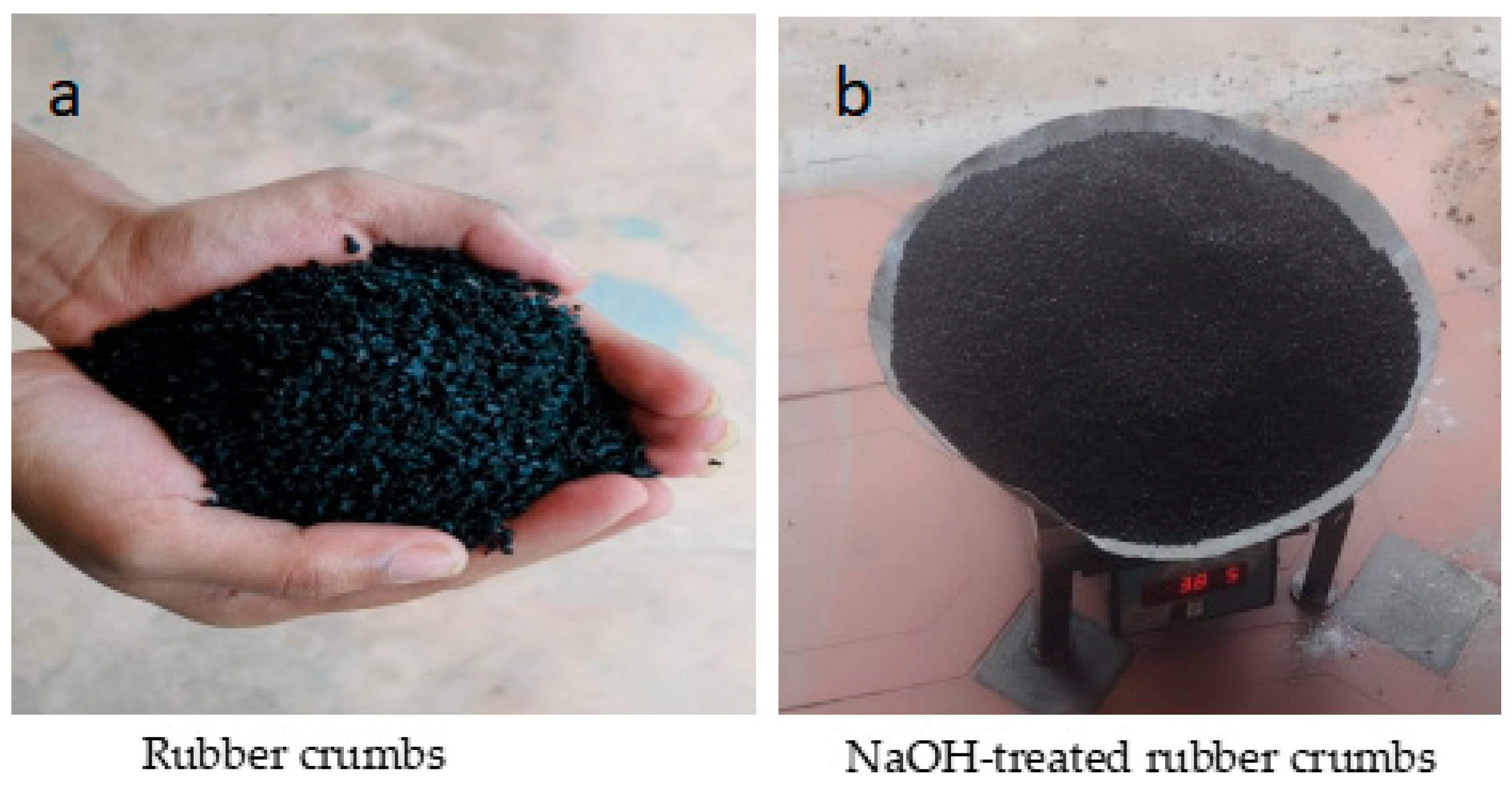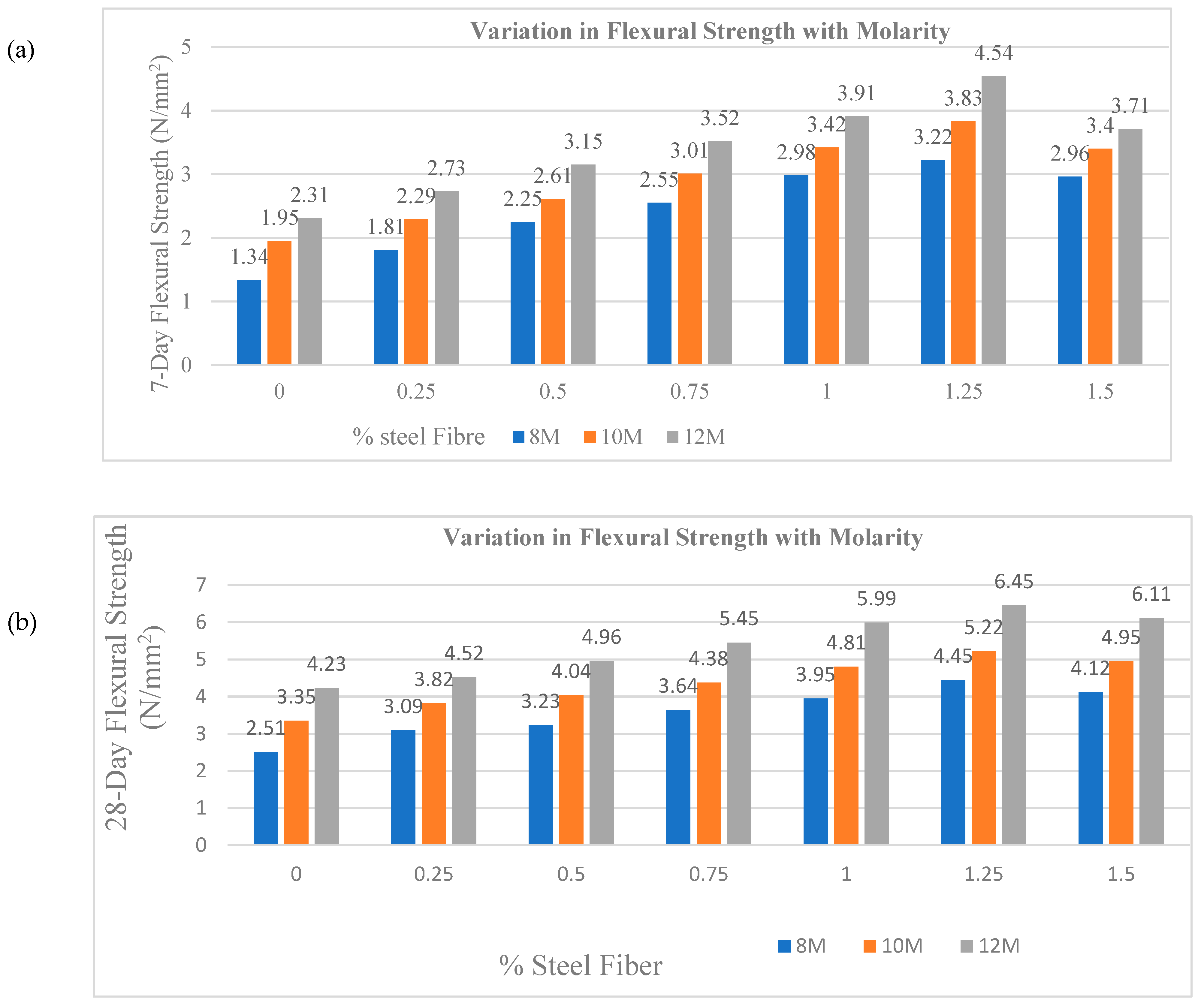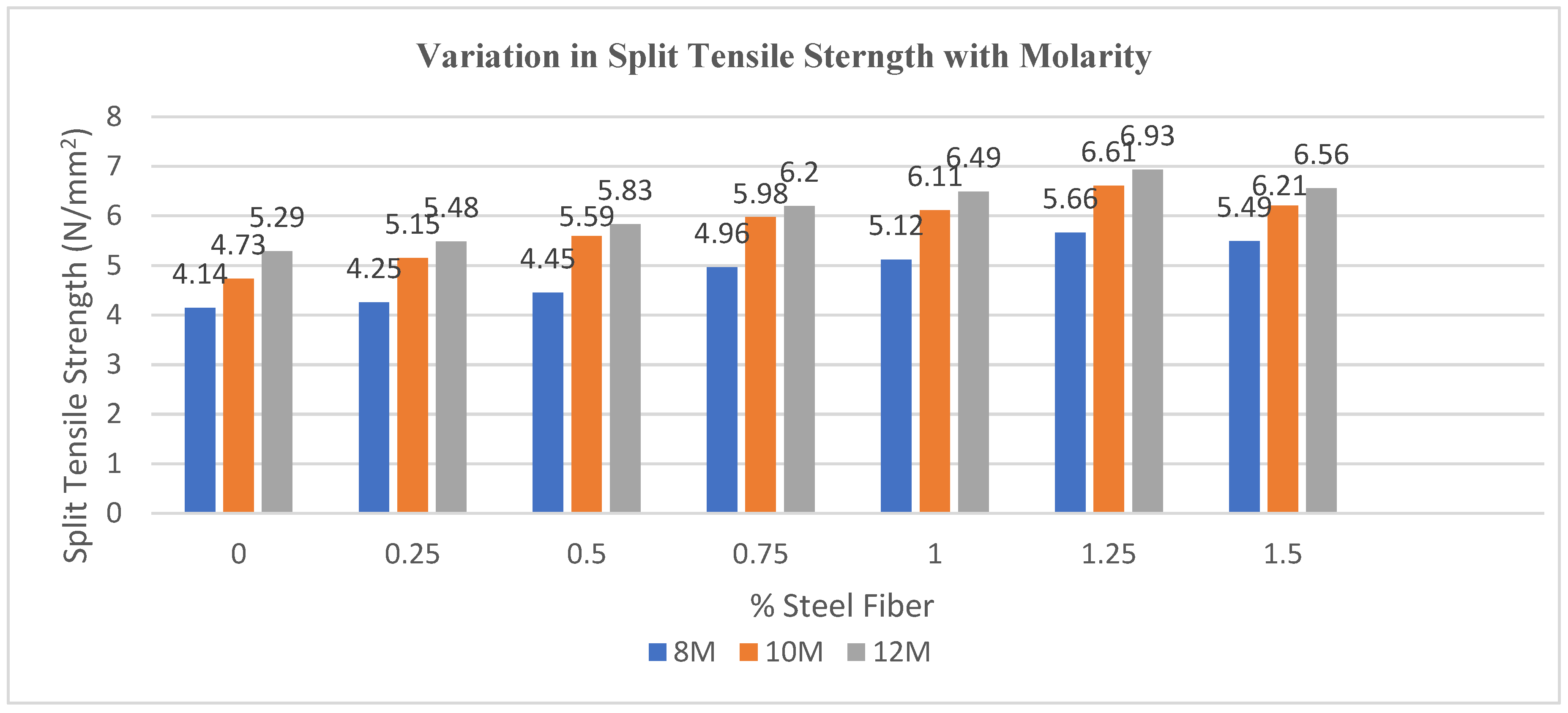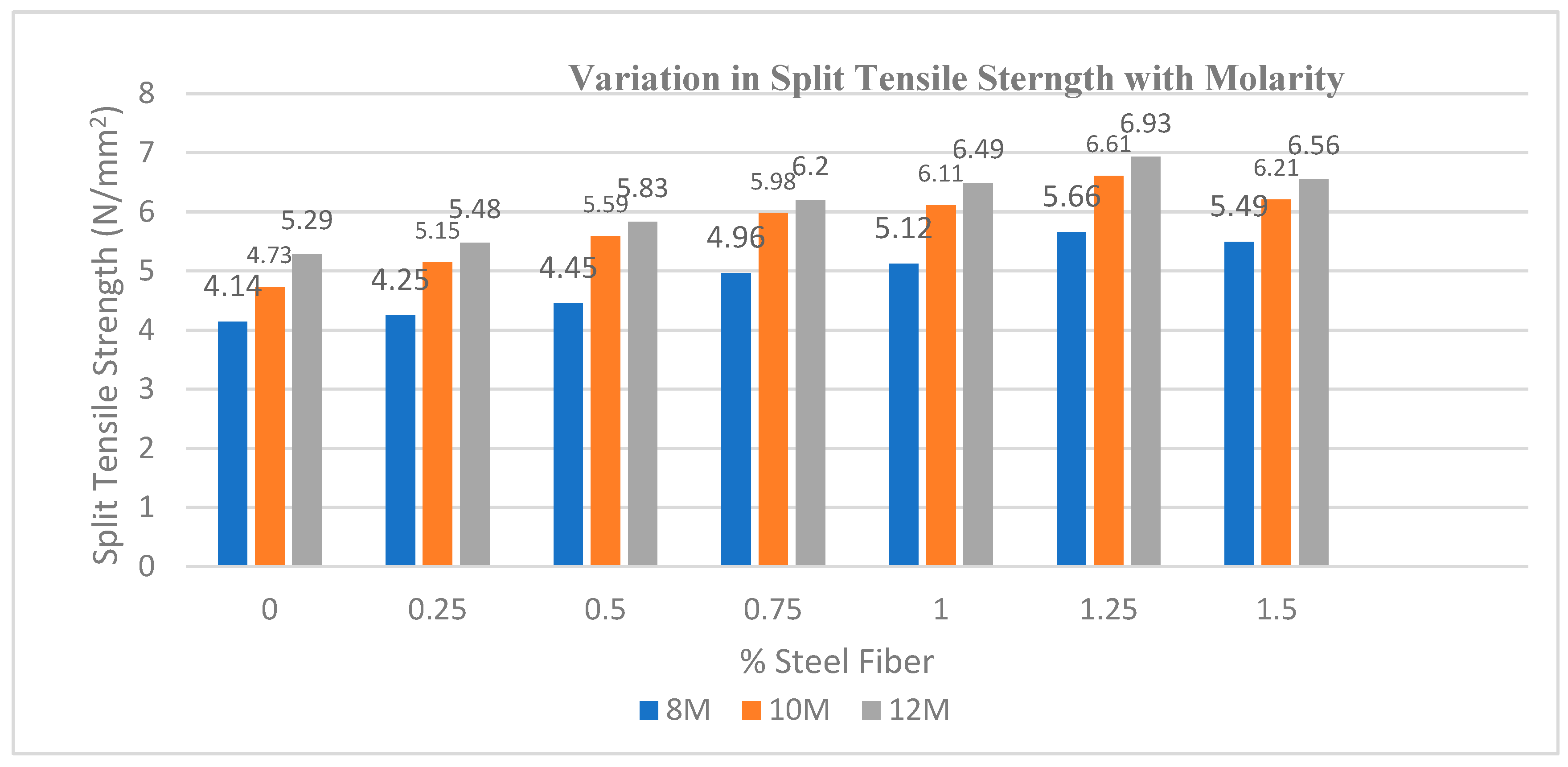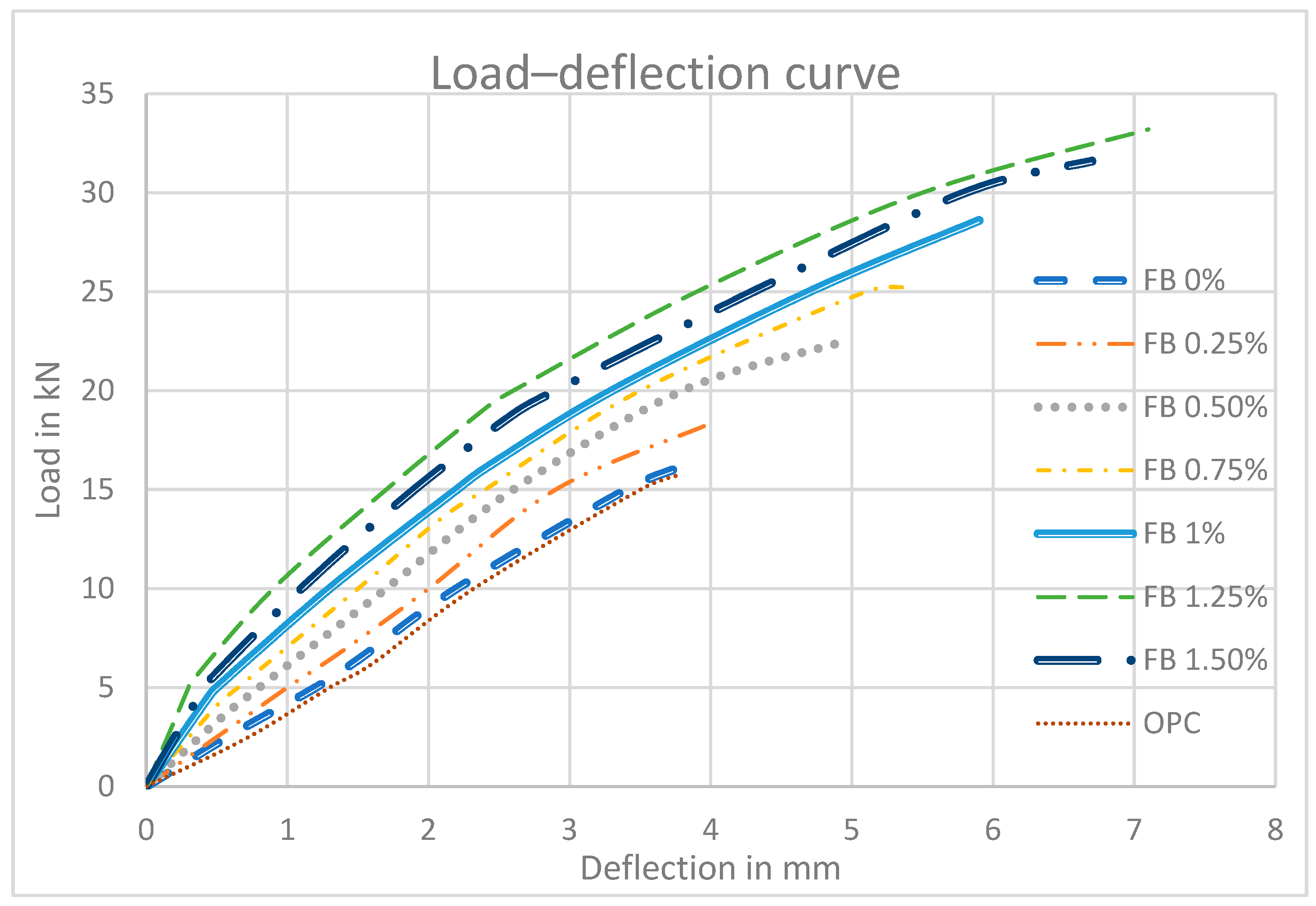Geopolymer concrete (GPC) represents an alternative to traditional concrete based on Portland cement, offering reduced carbon emissions and employing industrial by-products such as fly ash and ground granulated blast furnace slag (GGBFS). Recent research has examined the use of waste materials such as rubber crumbs as partial replacements for fine aggregates as a way to improve ductility under mechanical load, as well as to enhance energy absorption while alleviating environmental concerns [
1]. The lower stiffness and reduced strength of rubberized geopolymer concrete (RGC) limit its structural use, especially in shear-critical elements such as beams. Consequently, steel fiber has been included in RGC to improve the postcracking response and shear resistance of RGC beams [
2]. The effects of adding both straight and hooked-end steel fiber at various percentages, from 0% to 1.5%, on the shear carrying capacity of RGC beams determine the optimal fiber dosage to improve structural performance without compromising on functional sustainability. Fine aggregates in concrete can be partially substituted with rubber particles. Extremely elastic, wear-resistant, and stable in water, they improve durability, concrete hardness, and resistance to fractures, fatigue, and impacts [
3]. When used for structural elements such as walls and columns, rubberized concrete performs better seismically than traditional concrete [
4]. It also has a lower compressive strength, tensile strength, and elastic modulus, as rubber particles have a relatively low hardness compared to plain concrete. GPC is emerging as a compelling choice for modern infrastructure. By substituting carbon-emitting Portland cement with alkali-activated industrial waste products such as fly ash, GPC significantly minimizes embodied carbon. Its higher durability prevents chemical attack, freeze–thaw degradation, and fire, maximally increasing bridge longevity. This material strength, in conjunction with optimized design strategies, reinforces bridges to withstand earthquakes, floods, and climate-induced forces. Implementation thereby maximizes environmental sustainability while maximizing infrastructure lifespan and resilience [
5]. Because of its exceptional endurance, rubberized concrete has been used in structural slabs [
6], beams [
7], columns, frames, and steel–concrete composite constructions [
8]. However, despite its ductility, its decreased mechanical strength limits its engineering applications.
Shear failure is a brittle and undesirable failure mode in reinforced concrete beams and can be lessened by using shear reinforcements such as stirrups [
9]. The absence of shear reinforcements draws attention to the role of steel fiber in RGC as the only way to resist shear forces. The maximum extent of fine aggregate replacement with rubber crumbs was 20%. Although energy absorption improved, the shear strength was reduced. After water, concrete continues to be the most widely used material worldwide [
10]. Cement has been widely employed as the main binding ingredient in concrete in the building industry. The manufacturing of cement contributes roughly 5–7% of the world’s CO
2 emissions, which continue to be a major source of greenhouse gases (GHGs), and the Earth’s surface warming, which leads to global warming [
11]. Furthermore, the production of cement is a very energy-intensive process that requires almost 4 GJ of energy per ton, with an annual production of roughly 3.6 billion tons of cement [
12]. Cement production is increasing by almost 9% annually. GPC is a better alternative to ordinary Portland cement (OPC) because industrial waste materials can be used as source materials in GPC. Activator solution is used to activate these source materials. GPC beams with comparable target compressive strengths demonstrated comparable flexural behavior and strength to OPC beams [
13], with a comparable load-displacement response, initial cracking load, and ultimate load deflection under midspan. The insertion of steel fiber considerably alters a number of concrete member characteristics, including ultimate flexural strength, ductility, resistance to deformation and cracking, shear capacity, and hardness [
14]. Fiber is occasionally used in place of partially transverse steel reinforcements (such as vertical stirrups) in reinforced concrete (RC) elements to increase their shear strength [
15]. High-strength concrete is a form of concrete frequently employed in high-rise buildings due to its potential to lower section dimensions and dead load. It is also known to exhibit brittle behavior, though, which may result in structural problems. Adding steel fiber to high-strength concrete can enhance its ductility and mechanical qualities [
16]. The addition of both straight and hooked-end steel fiber is intended to restore and enhance shear resistance by bridging cracks and enhancing load transfer across them [
16,
17]. The value of comparing equal volumes of straight and hooked-end fiber is that the effect of fiber geometries on shear resistance can be evaluated [
18,
19]. Previous studies have promoted environmentally friendly, fiber-reinforced geopolymer concrete (FRGC) beams with improved shear strength and/or energy capacity, with the intention of developing sustainable structures that can maintain structural integrity within any built environment. Steel fiber-reinforced RGC beams have an enhanced shear capacity and ductility [
20]. Hence, they provide a sustainable and structurally efficient solution, with 1.25–1.5% of fiber dosage yielding the best shear performance. Steel FRGC beams have important uses in sustainable construction and lightweight structures, with seismic resistance and impact resistance applications in elements such as bridge decks, pavements, and precast components [
21,
22]. FRGC has been reported to exhibit strong mechanical bonds with concrete substrates and steel rebars as well as strong fire resistance, improved durability in corrosive environments, and reduced creep and shrinkage behavior [
23,
24]. The principal difficulty in its practical implementation is the absence of design codes on the structural performance of FRGC-rehabilitated concrete members [
25,
26]. The mechanical properties of RC beams are greatly influenced by the loading rate; a high loading rate triggers the shear effect of RC beams, transforming their failure mode [
27]. The shear failure of RC members is usually sudden and brittle; therefore, the design should ensure that the shear strength is at or greater than the flexural strength at every point along the member [
28]. Hence, the primary goal of shear design is to ascertain where shear reinforcement is necessary in order to avoid such a failure as well as to determine how much of it is required. Steel bar corrosion is one of the primary deterioration processes in concrete structures in marine environments [
29]. When used instead of Portland cement, geopolymer concrete tends to exhibit similar physical and durability properties to OPC [
30]. Research on the material properties of GPC has made significant advances [
31]; however, the number of large-scale tests conducted to assess its structural performance is still insufficient. A careful consideration using testing and computational modeling techniques can investigate such structural components and will provide greater support for RGC as a viable construction material. Manufacturing green concrete with recycled waste items such as rubber and other additives will become important in development strategies and pave the way for sustainable practices in roadway infrastructure developments [
32].
In spite of the known environmental advantages of GPC made with industrial waste materials such as fly ash and GGBFS, there is limited knowledge on the combined impact of recycled rubber and steel fiber reinforcement on the shear behavior of geopolymer concretes, especially under realistic curing and loading conditions. The majority of existing studies have emphasized compressive and flexural properties or have assessed rubberized and fiber-reinforced geopolymer concretes separately, without documenting the synergistic effect of combining both recycled rubber and steel fiber, particularly in terms of shear performance without stirrups. The motivation for this research study is to address the need for sustainable building materials that not only reduce carbon footprint but also use rubber crumbs without compromising on structural performance, with the aim of meeting or even surpassing traditional standards. This study is novel in the investigation of the interaction of NaOH molarity, steel fiber addition, curing regime, and recycled rubber fraction on both the mechanical and shear behavior of reinforced rubberized geopolymer concrete (RFRGC). The increase in the shear strength and energy absorption of non-shear-reinforced beams is measured and compared with code-based theoretical estimates and conventional concrete controls. The motivation for using rubber crumbs as an aggregate replacement in concrete is driven by the need to address both environmental and technical challenges. Existing limitations include a significant reduction in compressive and tensile strength, primarily due to the lower elastic modulus and poor adhesion of particles to cement paste, which leads to crack initiation and accelerated failure [
33]. These drawbacks are eliminated by the use of pretreated rubber crumbs for geopolymer concrete applications [
34]. The environmental benefits of recycling waste tires and reducing landfill burdens provide a strong motivation for continued research and optimizing rubberized concrete for sustainable use. By determining the ideal content of fiber and curing conditions for both maximum strength and ductility, this research paper differentiates itself from the previous literature and presents a feasible route for high-performance, sustainable concrete alternatives. The influence of steel fiber on enhancing the shear capacity of RFRGC beams is investigated, with the aim of developing sustainable structural solutions by integrating industrial by-products and waste materials. Key objectives include assessing the impact of fiber dosage on shear strength, crack initiation load, ultimate load, and energy absorption capacity derived from load–deflection curves. By identifying the optimal fiber percentage that maximizes shear enhancement, this research aims to advance eco-friendly concrete technologies, combining rubber, fly ash, and GGBFS with improved structural resilience and offer insights into sustainable alternatives to traditional reinforced concrete without compromising shear performance.
